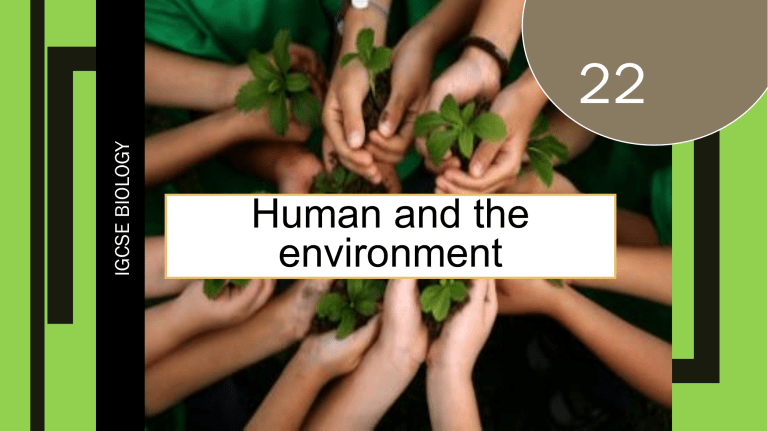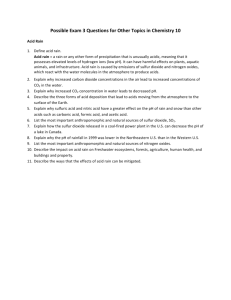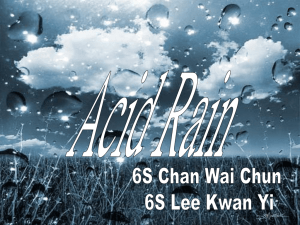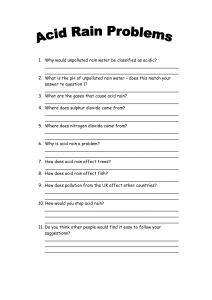
IGCSE BIOLOGY
22
Human and the
environment
21.3
Pollution
ACID RAIN ,NUCLEAR FALL OUT &CHEMICALS
LEARNING OBJECTIVE
• To explain the process of acid rain.
• To describe the harmful effects of radioactive
substances.
• To list the undesirable effects of dumping chemical
wastes into waterways.
Introduction
■ Human activities pollute the air, ground
and water. The effects of burning fossil
fuels include the production of acid rain
and an increased greenhouse effect.
Recycling is one way to reduce waste.
What are the sources of acid rain?
Sulphur dioxide, nitrogen oxides, Carbon monoxide
■ 1- Sulphur dioxide is produced from
factories, power stations, oil refiners,
burning of fossil fuels especially coal,
decaying organic matter, and volcanoes.
■ 2- Nitrogen oxides are produced from car
exhaust, lightning, factories, and
volcanoes.
■ 3-Carbon monoxide, CO, is produced when
fuels burn in a limited amount of air. It is a
colourless, odourless and tasteless gas.
How does the sources causes acid
rain?
■
Fossil fuels naturally contain sulfur
compounds. These produce sulfur
dioxide, a gas with a sharp, choking
smell, when the fuel is burned. This
is released into the atmosphere
where it combines with oxygen to
form sulfur trioxide When sulfur
trioxide dissolves in water droplets
in clouds, it makes the rain more
acidic than normal. This is
called acid rain.
■
When fuels are burnt in vehicle
engines, the high temperature
causes nitrogen in air to combine
with oxygen producing nitrogen
oxides.
■
Carbon monoxide, CO, is produced
when fuels burn in a limited
amount of air. Also carbon dioxide
dissolves in water and forms
carbonic acid. The pH of acid rain
will be low as 4
What are the undesirable effects
of Sulphur dioxide and carbon
monoxide?
■
■
■
■
■
Sulphur dioxide gas
1- Sulphur dioxide is an unpleasant gas.
2- It is an irritant causing difficulty in breathing.
3- Induces attack by asthma or bronchitis.
4- May diffuses through stomata of leaves and kills
mesophyll tissue if pollution continues.
■ 5- May dissolve in water vapor in the atmosphere,
condense and form clouds, then precipitate as sulphuric
acid or acid rains.
Carbon monoxide passes
into the red blood cells after
breathing it in. It binds more strongly
to haemoglobin than oxygen does,
so the blood will be able to carry less
oxygen than it should. This can
cause tiredness, unconsciousness
and even death.
Acid rain -Effects
1 - On plants: damage leaves; no photosynthesis; no
growth.
2- On soil and rivers:
a) - Acidic soil kills microorganisms such as bacteria and
fungi causing dead remains so accumulate due to slow
decay
b) - Also kills and damages fine roots of plants preventing
absorption of water and minerals; no growth
c)- Also washes out (leached) calcium ,magnesium and
aluminum ions from the soil; Aluminium ions accumulates in
rivers; these ions are toxic for fish as aluminum ions damage
their gills
3- On limestone buildings: corrosion of limestone or calcium
carbonate of buildings and damage stone statues
4- On bridges and metal railing: they collapse due to
corrosion of metals by acid rains
5- On long distance: acid rains may be carried by air for long
distances before they precipitate as acid rains e.g. the SO2
formed at coal mines of England and may fall as acid rain in
Norway
How to overcome these problems?
■ 1- Installing scrubbers which remove almost all the sulphur dioxide from the waste
gases at coal-power stations but this is very expensive to do. This often involves passing
the gases through a fine spray of lime.
■ 2- Using catalytic converter on car exhaust to convert nitrogen oxides into nitrogen
(catalytic converter does nothing for carbon dioxide emitted in the car exhaust).
■ 3- Use, alternative / renewable/ source of energy, example(s) nuclear, wind, wave, solar
hydrogen powers.
■ 4- Use low sulfur fuels
■
5- Reduce use of coal.
■
6- Use, more public transport e.g. walking / cycling
■ 7- Reduce the number of coal-burning power stations.
LEARNING OBJECTIVE
• To explain the process of acid rain.
• To describe the harmful effects of radioactive
substances.
• To list the undesirable effects of dumping chemical
wastes into waterways.
Nuclear
fallout:
■ Sources:
■ 1- Radioactive materials in the crust of earth
■ 2- Nuclear tests
■ 3- X-ray machines
■ 4- Cosmic radiations from the outer space
■ 5- Defects in nuclear power stations leading to leaking radiations or explosions by
nuclear bombs
■ Undesirable effects:
■ 1- Increasing the rate of mutations resulting in deformation of babies
■ 2- ionizing radiation – such as alpha, beta and gamma radiation damage DNA and genes
and causing cancer by affecting cell division. Alpha is the most ionising and so causes
the most damage, but only if it gets inside the body. This is because it is not able to
penetrate the skin. Gamma is the least ionising but the most penetrating.
■ 3- Radiation sickness leading to death
How to
overcome
these
problems?
1- Nuclear wastes must be buried
properly deep under the ground
in steel containers but this is
expensive
2- Never to leave or burn nuclear
wastes
3- Precautions must be taken in
nuclear power stations, reducing
nuclear tests, and find another
source of energy
LEARNING OBJECTIVE
• To explain the process of acid rain.
• To describe the harmful effects of radioactive
substances.
• To list the undesirable effects of dumping chemical
wastes into waterways.
■
1-lead, mercury, and cyanide compounds are
produced during industrial processes such as
electroplating, then these poisonous substances
enter aquatic organisms if released into rivers,
these compounds accumulates in a food chain
and reaches its highest concentrations in the top
consumer, then these compounds could affect
animals ,plants or humans who drink the water or
feed on fish. Some people died as these
compounds are enzymes' inhibitors, others
suffered from problems with their muscles and
nervous system, and deformed babies were born
How to overcome these problems?
■ 1- By treating wastes before discharging them into rivers.
■ 2-Petroleum oil from leaking or spilling tankers can kill sea birds, whales and harbor
seals. Also many aquatic plants and algae were affected as oil spill prevents
passage of light to the water and also prevents oxygen from being dissolved in water.
■ Oil spills are sucked by huge pumps, dissolved by chemicals, or degraded by special
bacteria into harmless compounds.
LEARNING OBJECTIVE
• To explain the process of acid rain.
• To describe the harmful effects of radioactive
substances.
• To list the undesirable effects of dumping chemical
wastes into waterways.
QUESTIONS
Refer page
303
Thank you







